Watermelon Peperomia Care & Propagation Guide
Written by Iris
Jan 04 2022
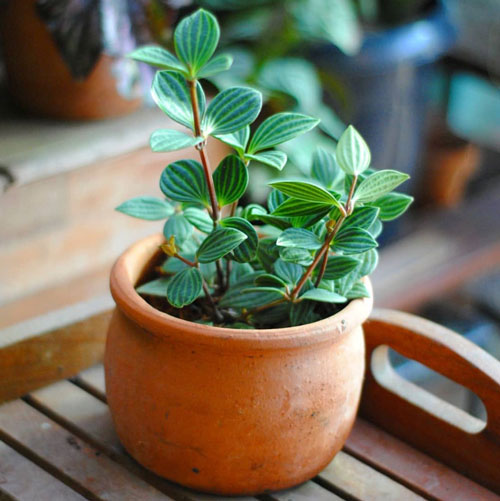
Watermelon Peperomia has drop-shaped leaves, with dark green veins and silver-gray veins, like the skin of a watermelon. The leaves are verdant and green. The appearance is very eye-catching. The green and white markings on the leaf surface look like small watermelons. , A glance can attract your attention deeply, this kind of plant is watermelon peel and pepper grass. This article will present the characteristics of Watermelon Peperomia in detail.
When to grow Watermelon Peperomia
The best time to propagate Watermelon Peperomia is in the springtime, just before the growing season begins. It is also possible to take cuttings and root them in the autumn when you bring outdoor Watermelon Peperomia plant in for the winter. The leaves of not-toxic Watermelon Peperomia are drop-shaped, with dark green veins and silver-gray veins, like the skin of a watermelon. The leaves are verdant and green. The appearance is very eye-catching. The green and white markings on the leaf surface look like small watermelons. , A glance can attract your attention deeply, this kind of plant is watermelon peel and Peperomia.Read More:
Is Watermelon Peperomia Toxic to Dogs?
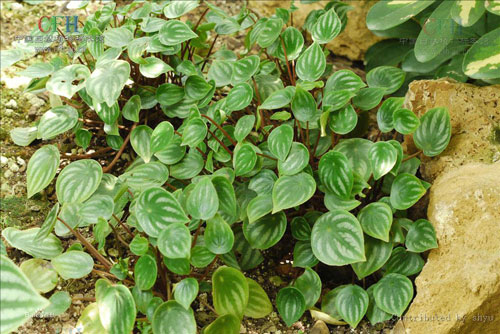
How to grow Watermelon Peperomia
Watermelon Peperomia Propagation with Stem Cuttings
To propagate Watermelon Peperomia from stem cuttings, follow these simple instructions:- Choose one or more healthy stems with a couple of dark green leaves each at the tip.
- Cut the stems off cleanly, just below the joint, using a sharp cutting implement. Leave only the two or three leaves at the tip of the stem, and remove any lower leaves.
- Dip the ends of the stems in a rootzone rooting hormone.
- Prepare a pot or seed tray of rooting medium and position your leaf cuttings an inch apart in the rooting medium by simply poking the stem ends into the prepared potting mixture.
- If you want to get fancy about it, use a dibbler (special tool intended just for this purpose) to make the holes instead of simply poking the stem end into the soil.
- Water the soil and press it down gently around the cuttings.
- If you are planning more than one type of Watermelon Peperomia, or if you simply wish to be sure of remembering which type you are planting, make a label stake to stick into the soil identifying your plants.
- Poke a few holes in a clear plastic bag and drape it lightly over the pot to help hold in humidity.
- Place the pot or tray in a setting with bright, indirect sunlight and a consistently warm temperature between 60° – 70° degrees Fahrenheit (15° – 21° C).
- If you're starting your cuttings in autumn, and you live in a very cool climate, you may need to supply bottom heat to keep the soil warm enough.
- Check on your cuttings daily, and lift the plastic bag away for an hour or so to encourage good air circulation and discourage fungal diseases.
Allow the young plantlets to grow for a week or two and then move them into their own pots.
Keep in mind Watermelon Peperomia have very shallow root systems, and the roots are somewhat delicate.
For this reason, you don't want to use a heavy potting soil mixture for mature plants.
When you transplant your new plants into their permanent pots, choose a shallow container and use a well-draining potting mix allowing good air circulation around the roots.
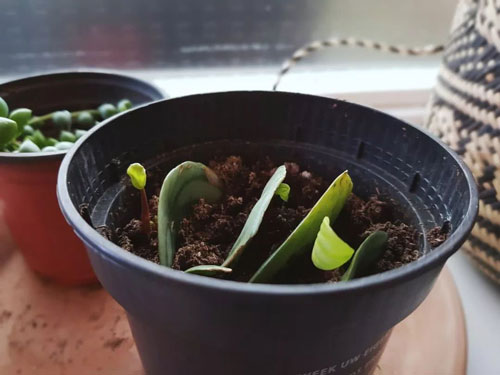
Watermelon Peperomia Propagation With Leaf Cuttings
To propagate Watermelon Peperomia using only leaf cuttings, simply choose a few healthy leaves and cut them off cleanly with a little bit of stem still attached.Dip this bit of stem into rooting powder and then follow the instructions given above.
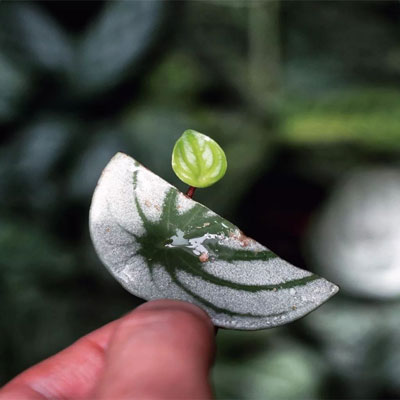
Watermelon Peperomia Propagation With Seeds
While it is possible to grow baby rubber plant Watermelon Peperomia from seed, this is certainly not the easiest or most advisable way.If you want offspring from an existing variegated plant, you must grow from cuttings.
Growing from saved seed will result in a non-variegated plant.
If for some reason, you do not have access to a parent plant or you want a specific type of Watermelon Peperomia which is not available in your area, purchase seeds online.
Be careful to purchase from reputable sellers who have excellent reviews. This can help ensure you are actually getting seeds for the type of Watermelon Peperomia you wish to grow.
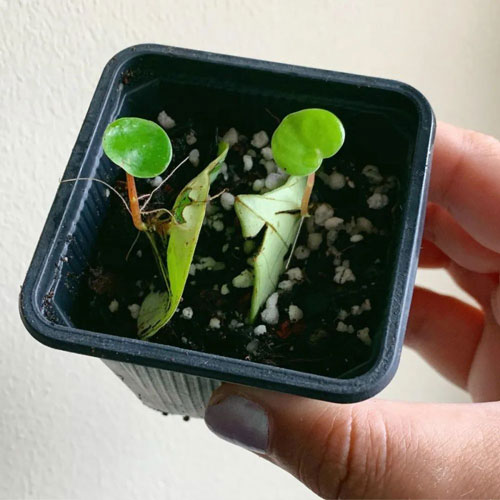
How to care for Watermelon Peperomia
Watermelon Peperomia Lighting
This plant will do best in bright indirect light. If it is exposed to too much light then you may find the colour and pattern of the leaves fade. If you find this is happening then move it slightly away from the light. However, these are not low light houseplants so do not place your Watermelon Peperomia in a place that receives little natural light as your plant will not be able to grow and thrive. Improper Lighting can result in Watermelon Peperomia Leaves Curling.You can play around with placement until your find the perfect lighting conditions to cultivate your Watermelon Peperomia. An east or west facing window will be able to provide your Watermelon Peperomia with the light it requires.
Read More:
How Much Light Does Watermelon Peperomia Need?
Watermelon Peperomia Soil Care
Loose, well-draining soil is key for Watermelon Peperomia plants. Opt for a houseplant potting mix with peat moss.Read More:
What Is The Best Soil For Watermelon Peperomia?
Watermelon Peperomia Watering
Make sure you water your Watermelon Peperomia thoroughly with each watering, soaking the soil through so that the roots have plenty of water. But make sure you let the soil dry out between each watering to avoid root rot. Its vital that you ensure your pot has adequate draining to avoid your Watermelon Peperomia from standing in water which can also be bad for the plant.
In summer and when the air is drier you will need to water your plant more often than in winter or in more humid conditions. Stick your fingers into the soil or use a soil moisture sensor to check how dry your soil is and when your plant needs a drink.
Read More:
How To Save My Watermelon Peperomia Root Rot?
Watermelon Peperomia Temperature & Humidity Care
A Watermelon Peperomia likes to be a bit warmer due to it coming from a tropical environment. It will not do well in freezing temperatures or near to a draught. A warm temperature will also help your Watermelon Peperomia to grow.Watermelon Peperomias are tropical plants, which means in their natural environment then are used to higher levels of humidity. If you live in a drier or more arid region then you may want to consider investing in a humidifier or you can buy a plant mister. If you are choosing to mist your plants then try to do this daily or every other day.
Another option to increase humidity for your plants is to place bowls or glasses of water around your plants. This will add moisture to the air as the water evaporates.
If you’re not sure whether you live in a humid region or not then you can buy a humidity detector to measure the level of moisture in your air.
Watermelon Peperomia Fertilizer
When fertilizing your Watermelon Peperomia, use a balanced, liquid, or water-soluble fertilizer. Avoid granular fertilizers that have a tendency to be too strong and can scorch the plant, which may result in Watermelon Peperomia Leaves Drooping.According to World of Flowering Plants, the Watermelon Peperomia is a light feeder, and too many nutrients may cause excessive growth causing the plant to become spindly, instead of bushy and compact.
A good rule of thumb is to dilute a standard indoor houseplant fertilizer to half of the recommended strength and fertilize every few months.
Watermelon Peperomia Pruning
There really is no need to prune these beautiful plants, but you can trim them whenever you feel they are growing a little out of control. Sometimes, cutting back the stem in early spring will help promote the lush appearance by encouraging more branching.Generally, spring and early summer is the best time to prune indoor plants because the warm weather and bright light aid in their fast recovery. When pruning, always use a sharp, clean pair of scissors to cut the plant’s stems.
Watermelon Peperomia Pests & Diseases
It is an essential aspect to know about any plants. In fact, Watermelon Peperomia does not have any serious diseases. However, spider mite, whitefly, and mealybug infestation can be a dangerous threat to the plant, which may result in Watermelon Peperomia brown spots.To deal with those pests, just remove them physically. Using a jet of water is also appropriate. Another thing you can do is to provide great ventilation in the area where you place the plant.

Watermelon Peperomia Varieties
Watermelon Peperomia is one of the cultivars in the Watermelon Peperomia family. This plant becomes a part of the Rosette Forming varieties.Besides Watermelon Peperomia, there are other plants that are part of this variety that form attractive rosettes on the leaves.
Silver Mount (Peperomia Griseoargentea), a bushy rosette of round cordate with glossy quilted leaves.
Emerald Ripple (Peperomia caperata), a mounding plant that has heart-shaped leaves with forest or dark green color.
Silver Heart (Peperomia Marmorata), the attractive heart-shaped leaves with a long point.
There many other varieties of Watermelon Peperomia. Many of them have become popular choices as part of indoor plant collection.
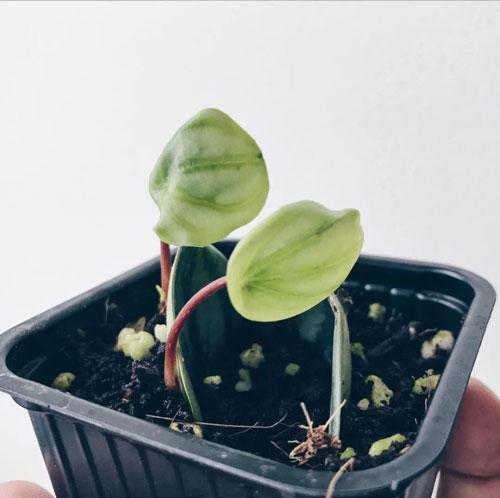
Watermelon Peperomia Care FAQ
Can You Propagate Watermelon Peperomia In Water?
Yes Watermelon Peperomia can be propagated in water, you simply take a leaf with the stem intact and place it into water. You can also propagate the plant in soil. If you take a leaf with part of the stem attached and place it into soil then your cutting should start to root and a new plant will begin growing in no time.Is Watermelon Peperomia A Succulent?
Although they have thick succulent leaves, it isn’t actually a succulent itself, and because of this requires different care than you would give a succulent, such as greater humidity, less intense light and more frequent waterings.Where Does The Watermelon Peperomia Come From?
The Watermelon Peperomia is native to South America but can now be found all over the world thanks to plant nurseries and international shipping. However, it’s important to remember the plants origins when you are thinking about its care as you will need to try and recreate its natural environment in your home setting in order to help it thrive.How Big Will My Watermelon Peperomia Grow?
A Watermelon Peperomia will grow to be around 12 inches tall, making it a perfect houseplant for small spaces. Although your Watermelon Peperomia won’t grow to a large size, if you want more of it around your home then you can take cuttings and make new watermelon Peperomia plants.Latest Updated
- Benefits of Bugleweed - 7 Science-backed Health Benefits
- Bugleweed Dangers & Side Effects - Is It Poisonous?
- How to Plant Evergreen Trees - What You Should Know
- When to Plant Evergreens - Grow Guide for Evergreen Trees
- 12 Wonderful Evergreen Shrubs for Your Garden
- 12 Popular Evergreen Plants with Pictures for Beginners
- When And How To Prune A Lilac Bush Like a Pro
- How to Grow & Care for Lilac Vine (Hardenbergia Violacea)
- Japanese Lilac Tree (Syringa Reticulata) Care & Propagation Guide
- Shumard Oak Pros and Cons - What to Know
Popular Articles
- Winter maintenance of Antirrhinum Majus
- How to Grow Terminalia Mantaly Tree
- How to Grow and Care for Crossostephium Chinense
- How to grow Antirrhinum Majus in spring
- Peristeria Elata (Dove Orchid) Profile: Info & Care Guide
- Underwatered Snake Plant (Sansevieria Trifasciata) - Signs And How To Fix
- How to Care for Brazilian Jasmine Plant (Mandevilla Sanderi)
- How to Grow & Care for Graptopetalum Purple Delight in Summer
- Rosa Chinensis (China Rose): Plant Growing & Care Tips
- How to Care for Baby Sun Rose (Aptenia Cordifolia)